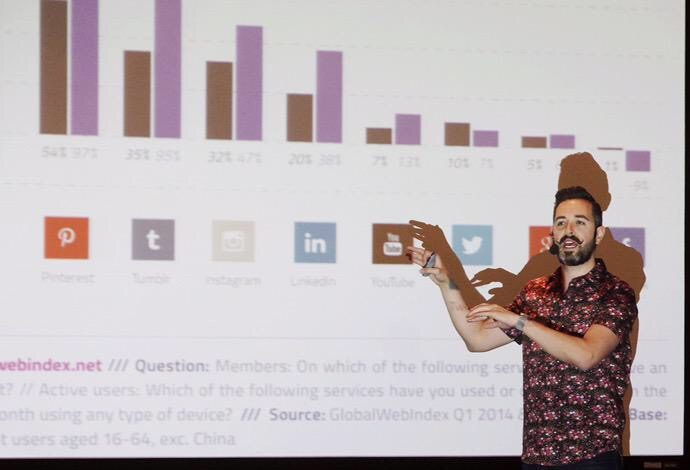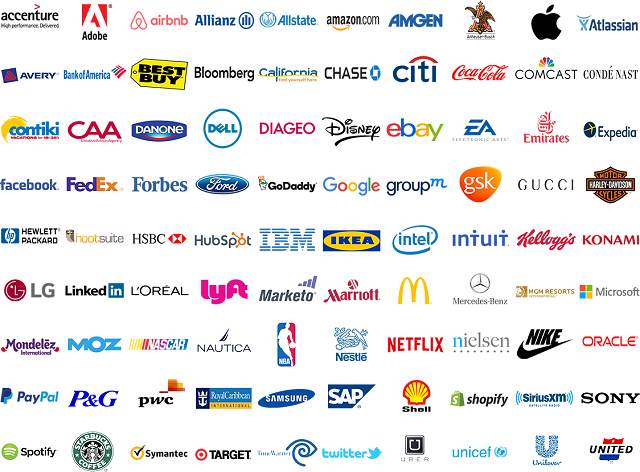Posts Tagged "Website Optimization"
Articles
- Best Marketing Conference Sponsorship
- What Does it Mean to Be an Exhibitor at a Conference?
- What Is the Biggest Social Media Conference?
- What Is an Innovation Conference?
- What Is a Typical B2B Event?
- What Are the Cloud Technology Events in 2025?
- Marketing Event Volunteer Opportunities: A Comprehensive Guide
- Digital Marketing Event Volunteer Opportunities Near Me
- What Does a Volunteer Do at a Conference?
- Is DigiMarCon Worth It?
- Is DigiMarCon Good?
- What is the Biggest Marketing Forum?
- What are Digital Marketing Conferences?
- Marketing Conference Exhibiting: Your Guide to Success
- Digital Summit Comparison: A Closer Look at DigiMarCon
- Digital Marketing Conference
- Digital Marketing Events: Your Guide to Success in 2025
- Marketing Conferences: Unlocking Your Business Potential in 2025
- What Is The Future of Digital Marketing in 2030?
- B2B Event Marketing Strategy: Unlocking Success For Your Business
- Why B2B Event Marketing?
- What Should a B2B Marketing Strategy Include?
- Top Marketing Conferences for 2025
- What Is the Future of Marketing in 2025?
Digital Marketing Conferences
- NORTH AMERICA
- DigiMarCon Cruise
(New Orleans, LA, USA) - DigiMarCon West
(Los Angeles, CA, USA) - DigiMarCon Northwest
(Seattle, WA, USA) - DigiMarCon Canada West
(Vancouver, BC, USA) - DigiMarCon Canada
(Toronto, ON, Canada) - DigiMarCon Canada East
(Montreal, QC, Canada) - DigiMarCon Florida
(Orlando, FL, USA) - DigiMarCon Gulf Coast
(Houston, TX, USA) - DigiMarCon Southern California
(San Diego, CA, USA) - DigiMarCon Midwest
(Chicago, IL, USA) - DigiMarCon Mid-South
(Nashville, TN, USA) - DigiMarCon Great Lakes
(Detroit, MI, USA) - DigiMarCon North
(Minneapolis, MN, USA) - DigiMarCon Central
(Kansas City, MO, USA) - DigiMarCon Texas
(Dallas, TX, USA) - DigiMarCon New England
(Boston, MA, USA) - DigiMarCon Mid-Atlantic
(Philadelphia, PA, USA) - DigiMarCon South Florida
(Miami, FL, USA) - DigiMarCon Southeast
(Atlanta, GA, USA) - DigiMarCon Central Florida
(Tampa, FL, USA) - DigiMarCon East
(New York, NY, USA) - DigiMarCon South Atlantic
(Charlotte, NC, USA) - DigiMarCon America
(Washington, D.C. USA) - DigiMarCon Northern California
(San Francisco, CA, USA) - DigiMarCon Rocky Mountains
(Denver, CO, USA) - DigiMarCon South
(San Antonio, TX, USA) - DigiMarCon Silicon Valley
(San Jose, CA, USA) - DigiMarCon Orange County
(Anaheim, CA, USA) - DigiMarCon Southwest
(Phoenix, AZ, USA) - DigiMarCon World
(Las Vegas, NV, USA)
- DigiMarCon Cruise
- LATIN AMERICA
- EUROPE
- MIDDLE EAST
- AFRICA
- ASIA PACIFIC
- DigiMarCon Hawaii & Pacific
(Honolulu, HI, USA) - DigiMarCon Asia & Japan
(Tokyo, Japan) - DigiMarCon New Zealand
(Auckland, New Zealand) - DigiMarCon Australia
(Sydney, Australia) - DigiMarCon Oceania
(Melbourne, Australia) - DigiMarCon Southeast Asia
(Singapore) - DigiMarCon India
(New Delhi, India) - DigiMarCon North Asia & China
(Shanghai, China)
- DigiMarCon Hawaii & Pacific
- VIRTUAL
Digital Marketing Blog
- DigiMarCon for Startups: Why Founders Shouldn’t Miss It October 29, 2025
- DigiMarCon Recap: What Went Down and What’s Next October 29, 2025
- The Best Quotes from DigiMarCon That Will Inspire Your Next Campaign October 29, 2025
- Innovations Unveiled: The Coolest Tech at DigiMarCon Conference & Exhibition October 29, 2025

































Unlock Website Traffic Growth: 10 Proven Hacks to Try
In today’s digital world, being seen online is key for businesses to grow. Website traffic growth is a top goal for companies. They look for new ways to get more people to visit their sites.
Studies show businesses want to find effective ways to get more site visitors. We’ve gathered a list of 10 proven hacks to boost your online traffic. These tips can help your business succeed.
Key Takeaways
The Strategic Value of Driving More Website Visitors
Getting more people to visit your website is key in digital marketing. But, it’s not just about how many visitors you get. The quality of those visitors matters a lot. It affects how well your online presence works.
Why Traffic Quality Matters More Than Quantity
Getting the right people to visit your site is crucial. A study by HubSpot shows that focusing on SEO helps a lot. SEO brings in better traffic that’s more likely to interact with your content.
Setting Realistic Traffic Growth Goals
To grow your traffic in a meaningful way, you need to set goals that are realistic. You should know who your audience is, look at your competitors, and find ways to make your site more visible. Setting goals that you can reach helps you focus on strategies that increase organic traffic.
Measuring Success Beyond Just Visitor Numbers
Success on your website isn’t just about how many people visit. You also need to look at engagement, conversion rates, and bounce rates. These metrics give you a full view of how your site is doing. By using them, you can make your organic traffic strategies better and improve your site’s performance.
To boost website SEO, focus on quality traffic and set realistic goals. This way, you can grow your traffic in a meaningful way and meet your marketing goals.
Hack #1: Optimize Your Content for Featured Snippets
Optimizing your content for featured snippets can greatly improve your website visibility. It also helps drive more traffic to your site. Featured snippets are short summaries that show up at the top of Google’s search results. They give users a quick answer to their questions.
How Featured Snippets Drive Significant Traffic
A study by Ahrefs found that featured snippets can boost website traffic by up to 20%. They are very visible and often get clicked more than other search results. By making your content snippet-friendly, you can increase your online presence and draw more visitors.
Formatting Content for Snippet Optimization
To make your content snippet-friendly, format it for search engines. Use clear headings, short paragraphs, and structured data.
List-Based Snippet Formatting
List-based content works well for featured snippets. It gives a clear, concise answer to the user’s question. Use
or
tags to structure your list.
Paragraph Snippet Optimization
For paragraph snippets, aim for a clear, concise answer. Use short paragraphs and avoid jargon or technical terms.
Tools to Track Featured Snippet Opportunities
Several tools can help you find featured snippet opportunities. Ahrefs, SEMrush, and Moz are some examples. They show you which keywords and content are featured, helping you optimize your content.
As
, optimizing for featured snippets needs a strategic approach. But the benefits are worth it.
Hack #2: Leverage the Skyscraper Technique for Link Building
The Skyscraper Technique is a strong link building method. It helps websites grow their online presence. You find top content in your field, make it better, and then ask other sites to link to it.
Finding Top-Performing Content in Your Niche
To use the Skyscraper Technique, first find the best content in your field. Use tools like Ahrefs or SEMrush for this. Look at shares and backlinks to see what people like.
A study by Moz shows that good backlinks help content rank better. This is important for your site’s success.
Creating Superior Content That Outranks Competitors
After finding great content, make something even better. Update stats, add new insights, or improve visuals. This makes your content more valuable and linkable.
For example, if someone has “10 tips,” make a guide with “20 tips.” This gives more value to readers.
Outreach Strategies for Maximum Link Acquisition
Once you have great content, it’s time to reach out. Find sites and influencers that might link to you. Make your emails personal by explaining why your content is good for their audience.
A study shows that personal emails get more responses. This can lead to more backlinks.
Email Outreach Templates That Work
Good email templates can make link building easier. Your template should introduce yourself, explain your content’s value, and ask for a link. For example, say, “I loved your article on [topic]. I made an even better version that I think your readers will like.”
Following Up Without Being Pushy
It’s important to follow up on your email without being too pushy. A polite second email can help a lot. Wait a few days before following up to give the other person time.
Hack #3: Implement Strategic Internal Linking Architecture
Strategic internal linking is key to a better website. It makes your site easier to navigate and boosts search rankings. This approach also improves user experience and keeps visitors engaged.
Identifying Your Pillar Content Pages
Pillar content pages are the heart of your site’s linking structure. They’re in-depth, high-quality pages that focus on a single topic. Look for content that:
Creating Topic Clusters Around Main Themes
Topic clusters group related content around a main theme or pillar page. This approach:
A SEMrush study found that internal linking can increase website traffic and engagement. By linking smartly to and from pillar pages, you spread link equity and make related content more visible.
Using Internal Links to Boost Underperforming Pages
Internal linking can breathe new life into underperforming pages. Linking these pages from high-traffic or pillar pages can increase their visibility. Here are some strategies:
Hack #4: Optimize for Voice Search Queries
Voice search is getting more popular, and it’s important to make your content voice-friendly. A Google study shows many people now use voice assistants for searching. This means you need to make your content work well for voice search.
Understanding Voice Search Behavior Patterns
Voice search users talk more like they’re having a conversation. They ask questions directly. For example, they might say, “What are the best restaurants in New York?” instead of typing it.
Incorporating Conversational Long-Tail Keywords
To get better at voice search, use conversational long-tail keywords. This means using phrases that sound like how people speak. For example, instead of “best Italian restaurants,” try “What are the top-rated Italian restaurants near me?”
Creating FAQ Content Specifically for Voice Search
FAQ content is great for voice search. By answering common questions on your site, you’re more likely to show up in voice search results. Keep your answers clear, concise, and up-to-date.
By using these tips, you can make your website more visible in voice search. This can bring more visitors to your site and improve your online presence.
Hack #5: Harness the Power of Social Media Algorithms
Social media algorithms are key to how visible your content is and how much traffic it gets. To boost your online presence, it’s crucial to grasp how these algorithms work. Then, adjust your content strategy to fit.
Platform-Specific Content Distribution Strategies
Each social media platform has its own algorithm that likes certain types of content. For example, Instagram loves eye-catching visuals, while LinkedIn prefers professional and informative posts.
Instagram-Specific Tactics
To do well on Instagram, make sure your visuals are top-notch and engaging. Use Instagram Stories and Reels to reach more people and send them to your website.
LinkedIn Content Optimization
On LinkedIn, make your content better by using the right keywords, catchy headlines, and long-form posts. This helps you show you’re an expert in your field.
Timing Your Posts for Maximum Visibility and Clicks
When you post on social media can really affect how many people see it and click on it. Try posting at different times to see when your audience is most active.
Leveraging Social Media Communities to Drive Traffic
Getting involved in social media communities related to your field can bring more traffic to your site. Join in on discussions, share useful content, and connect with others in the community.
A study by Hootsuite shows social media can really boost website traffic. By using these strategies and keeping up with algorithm changes, you can drive more traffic to your website and meet your online marketing goals.
Hack #6: Create Strategic Content Partnerships
Strategic content partnerships are a great way to get more people to visit your website. By working with other brands or influencers, you can reach new audiences. This helps you create content that more people will find interesting.
Identifying Complementary Brands for Collaboration
Finding the right partners is the first step. Look for brands that have the same audience but aren’t your competitors. For example, a fashion brand might team up with a beauty influencer. This way, they can make content that appeals to more people.
A study by Content Marketing Institute shows that these partnerships can really help your website. They can make your site more visible and bring in more visitors.
Co-Creating Valuable Content That Drives Traffic
After finding potential partners, work on creating valuable content together. This could be blog posts, webinars, or podcasts. The goal is to make content that is both useful and fun for your audience.
For example, a tech company and a marketing firm could make a webinar on digital marketing trends. This would give people useful information and bring more visitors to both sites.
Cross-Promotion Tactics That Benefit Both Parties
Good cross-promotion is key to making partnerships work. Both sides should share the content on their social media, email newsletters, and blogs. This helps more people see the content and makes both brands look good.
By using each other’s followers, you can grow your online presence. This will bring more visitors to your website.
Hack #7: Optimize Page Speed for Better User Experience and Rankings
Page speed is key for a better website ranking and user experience. Google found that page speed matters a lot for ranking. A slow site can cause people to leave quickly, hurting your online image.
Measuring Your Current Page Speed Metrics
To boost page speed, start by checking your current metrics. Use Google PageSpeed Insights to see how fast your site is. It gives you a detailed report and tips to make it faster.
Image and Video Optimization Techniques
Images and videos are important but can slow down your site. Use tools like TinyPNG or ImageOptim to make images smaller without losing quality. For videos, host them on YouTube or Vimeo to lighten your site’s load. Also, use lazy loading to only load media when it’s needed.
Server Response Time Improvements
Improving server response time is crucial for page speed. Here are some tips:
Choosing the Right Hosting Solution
Choosing the right hosting is vital for page speed. Look for a host with fast servers, SSD storage, and a CDN for the best performance.
Implementing Caching Effectively
Caching can greatly improve page speed by storing often-used resources. Use browser caching, server-side caching, or a caching plugin. This reduces server load and speeds up responses.
Hack #8: Implement Targeted Email Marketing Campaigns
Targeted email marketing can really boost website visits. A study by Mailchimp shows it can drive a lot of traffic. This happens when you make the content personal, so it speaks to the recipient.
Segmenting Your Email List for Personalized Outreach
Segmenting your email list makes your outreach more personal. You sort your subscribers by what they like, how they act, or who they are. This way, you can send messages that really hit home, making them more likely to visit your site.
Creating Email Content That Drives Website Visits
The content of your emails is key to getting people to visit your site. Compelling subject lines, engaging body content, and clear calls-to-action (CTAs) are must-haves. For example, a special offer or exclusive content can really get people to click.
Measuring Email-to-Website Conversion Rates
To see how well your email marketing works, you need to track your conversion rates. Look at click-through rates (CTRs), conversion rates, and ROI. This helps you tweak your campaigns for better results.
Many companies, like Amazon and Netflix, have seen great success with email marketing. They send emails that are very personal, which boosts engagement and site visits. By learning from them and always checking your results, you can grow your website traffic too.
Hack #9: Leverage Video Content for Increased Engagement
Video content is key in the digital world for grabbing attention and boosting website traffic. A Vidyard study found that using video can really up your website engagement game.
Types of Videos That Consistently Drive Traffic
Some videos are better at getting people to visit your site. Here are a few:
Optimizing Videos for Search Engine Visibility
To get the most out of your videos, make sure they’re easy for search engines to find. Here’s how:
Cross-Platform Video Distribution Strategies
Sharing your videos on different platforms is key to reaching more people. Here’s where to start:
Hack #10: Implement Advanced Website Traffic Growth Hacks Through Content Updates
Updating old content can be as good as making new content to draw visitors. Refreshing and republishing old pages can make them new again. A study by Clearscope shows that updating content can boost search visibility and bring in more traffic.
Identifying High-Potential Content Refresh Opportunities
To get the most from content updates, find the best pages to update. Use tools like Google Analytics to see which pages need a boost. Look for pages with:
Adding New Information and Insights to Existing Content
When updating, add new insights, data, or info to make the content better. This makes the content more relevant and valuable. Think about adding recent statistics, expert opinions, or case studies to enrich it.
Republishing Strategies for Maximum Search Visibility
After updating, it’s key to have a plan to get your content seen more. This includes:
By using these strategies, you can make your website more visible to search engines. This will help bring more visitors to your site.
Conclusion: Building Your Customized Traffic Growth Strategy
Using the right website traffic growth hacks can really help your online presence. A study by Ahrefs shows that using many strategies can help businesses meet their marketing goals. By using the 10 proven hacks from this article, you can make a plan that works for your site.
Creating a customized strategy means knowing your audience, looking at your competitors, and picking the best hacks. This could be making your content better for featured snippets, using the Skyscraper Technique, or improving your internal links.
By mixing these strategies and keeping an eye on your site’s performance, you can make your plan even better. Aim to build a strong strategy that matches your business goals. This will help you get more visitors and reach your marketing targets.
FAQ
What are the most effective ways to boost website SEO and drive organic traffic?
Optimizing content for featured snippets is key. The Skyscraper Technique helps with link building. Strategic internal linking also boosts SEO and drives traffic.
How can I improve my website’s visibility on search engines?
To improve visibility, focus on page speed and quality content. Use social media to drive traffic too.
What is the importance of quality traffic over quantity?
Quality traffic matters more than quantity. It boosts conversion rates and success. Targeting the right audience leads to higher engagement and ROI.
How can I measure the success of my website traffic growth strategies?
Track visitor numbers, engagement, and conversion rates. Google Analytics offers insights into your website’s performance.
What role does content play in driving website traffic?
Content is crucial for driving traffic. High-quality, engaging content attracts and retains an audience. It boosts SEO too.
How can I optimize my content for voice search queries?
Understand voice search patterns and use conversational keywords. Create FAQ content for voice search.
What are some effective email marketing strategies to drive website traffic?
Segment email lists for personalized outreach. Create content that encourages website visits. Track email-to-website conversion rates.
How can I leverage video content to increase engagement and drive traffic?
Create videos that drive traffic. Optimize videos for search visibility. Use cross-platform distribution strategies.
What are some advanced website traffic growth hacks through content updates?
Identify content refresh opportunities. Add new insights to existing content. Republish for maximum search visibility.
Elevate Your Website with Exceptional UI/UX Design
In today’s digital world, a website’s success depends on its user experience. A well-designed site can grab visitors’ attention, keep them engaged, and boost sales. At the core of this is exceptional UI/UX design, making a website more than just functional.
A site that looks good and is easy to use can make users happy. This happiness leads to loyalty and positive word-of-mouth. By focusing on user experience, businesses can stand out online.
Key Takeaways
The Critical Role of Design in Digital Success
In today’s digital world, user interface design is key. A good website is more than pretty; it’s a tool for businesses to connect with their audience and boost sales.
Great web design means making a site easy to use. It’s about knowing how people use your site and making it easy for them to get what they need. This could be buying something, signing up for a newsletter, or just finding info.
Good design helps keep users interested. For example, a clear menu lets people find what they need fast. This cuts down on people leaving your site and keeps them there longer. Plus, a site that works on all devices makes it easier for everyone to use.
Also, good design can lead to more sales. By making the checkout process easy and calls-to-action clear, you can get more people to take action. And if your site loads fast, even better.
In short, design is vital for digital success. It’s not just about looks; it’s about making a site that works well and keeps people coming back. So, investing in top-notch web design is crucial for any business wanting to succeed online.
Understanding UI/UX Design: Core Concepts and Principles
UI/UX design is key for making digital products look good and easy to use. It combines many disciplines to make interfaces that engage and are easy to navigate.
User-centered design is at the heart of UI/UX. It focuses on knowing what users need and how they behave. This way, designers can make products that fit their audience, making users happier.
Interaction design is also vital. It’s about making the interactions between users and digital products smooth. Designers work on making navigation easy, feedback clear, and transitions smooth, all for a better user experience.
In mobile app design, UI/UX is even more important. With small screens and different user situations, designers must think carefully about layout, typography, and colors. This ensures the best experience on smaller screens.
To get UI/UX right, designers need to mix beauty with usability. They must make sure digital products look good and are easy to use. By following UI/UX principles, designers can meet user needs and help businesses succeed.
Core Principles of Exceptional UI/UX Design
UI/UX design is more than just looks. It’s about making digital spaces inclusive and accessible for everyone. This means digital products should work well for all, no matter their abilities. At its heart, UI/UX focuses on usability and user-centered design.
The WCAG Guidelines are key to inclusive design. They offer a detailed plan for making digital stuff easier to use. Important parts include:
WCAG Guidelines and Inclusive Design
Following WCAG guidelines is more than following rules. It’s about making design that welcomes everyone. This means adding features like text for images and easy-to-follow paths.
Designing for All Abilities
Designing for all abilities means thinking about many user needs. This includes cognitive, learning, physical, and sensory disabilities. It’s about making a user experience that’s flexible and enjoyable for all.
To do this, designers use several methods, like:
By following these principles, designers make UI/UX experiences that are top-notch and accessible to many. This boosts user happiness and grows the audience for digital products.
The User-Centered Design Process
The user-centered design process puts the user first. It makes sure UI/UX designs really meet what users need and want. This method digs deep into how users act, what they struggle with, and their habits. It covers many steps, from learning about users to testing how easy the design is to use.
The first step is user research. Designers talk to people, do surveys, and watch how they act. This helps find out what users like and need, guiding the design choices.
After learning about users, designers start making prototypes. Prototyping is key in UI/UX design. It lets designers see and use the product before it’s made. There are two kinds of prototypes: simple, rough ones and detailed, interactive ones.
Low-Fidelity vs. High-Fidelity Prototypes
Low-fidelity prototypes are simple, like drawings on paper. They check if basic ideas and layouts work. High-fidelity prototypes are more detailed and interactive. They look a lot like the real product and test how well it works.
Prototyping Tools and Techniques
Many tools and methods help make prototypes. Sketch, Figma, Adobe XD, and InVision are some of them. These tools help designers make interactive prototypes. These can be tested with real users, giving feedback to improve the design.
This design process keeps going back and forth. It keeps testing and getting better until the product is just right. This way, designers make designs that look good and work well for users.
Mobile-First Design Strategies
In today’s world, making your website mobile-friendly is essential. Most people use their phones to browse the internet. So, designing for mobile first is key to a great user experience.
When designing for mobile, think about screen size, how fast it loads, and what content is most important. Start by making a website for small screens, then adjust it for bigger ones. This way, mobile users get the most important stuff first.
How fast your website loads is very important, even more so on mobile. A slow site can make people leave quickly. To speed things up, reduce file sizes, use browser caching, and CDNs.
Optimizing Images and Media
Big, unoptimized images can slow down your site. To fix this, compress images with tools like TinyPNG or ImageOptim. Also, use lazy loading for media that’s not needed right away.
By focusing on mobile design and optimizing images and media, you can make a website that works well on all devices. This leads to better user experience, more engagement, and higher success for your business.
Current Trends in UI/UX Design
The world of UI/UX design is changing fast. New tech and how people use it are leading the way. Designers and companies need to keep up with these changes.
Mobile-First Design: Most people use digital stuff on their phones. So, mobile-first design is key. It makes sure apps and websites work well on small screens.
Dark Mode and Minimalism: Dark mode and minimalist design are big now. They look good and save battery. These styles make digital things look modern and easy to use.
Voice UI and Conversational Design: Voice assistants are getting popular. This means more focus on voice UI and talking to digital stuff. It makes using digital products feel more natural.
Personalization and AI-Driven Design: AI is making personalization possible. It uses data to make things just right for each person. This makes users happier and more engaged.
UI/UX design keeps getting better. It’s important for experts to follow these trends. This way, they can make designs that are both new and focused on the user. This leads to success in the digital world.
Essential Tools for Modern UI/UX Design
Modern UI/UX design uses many tools for different design steps. These tools help make designs look good and work well. They also make sure designs are easy for users to use.
The design journey starts with making wireframes and prototypes. Figma, Sketch, and Adobe XD are top picks for this. They let designers make detailed designs and work with teams in real-time.
Figma, Sketch, and Adobe XD
Figma is great for teams working from home because of its cloud-based features. Sketch is loved by macOS users for its easy-to-use interface and many plugins. Adobe XD works well with other Adobe apps, offering a full design solution.
After the design is done, prototyping and testing come next. InVision and Marvel help make interactive prototypes. This lets designers check how well their designs work.
InVision and Marvel
InVision is known for making complex prototypes and managing projects well. Marvel has a simple design for making and testing prototypes. It’s easy for designers of all levels to use.
UI/UX designers use these tools to improve their projects. They help with teamwork and making prototypes. These tools are key to modern design.
In summary, the right tools are crucial for good UI/UX design. By picking the right tools for each design step, designers can make sure their work is top-notch.
Implementing UI/UX Design Across Different Website Types
UI/UX design changes a lot for different websites. It’s all about knowing what users need and how they act. Good design makes websites better for users, no matter if they sell things, share info, or entertain.
E-commerce sites need user-centered design the most. They should make shopping easy and fun. A well-made e-commerce site can make more sales and happy customers.
By making checkout easier, sites can make users happier and more likely to buy.
Product Page Design Best Practices
Product pages are very important for e-commerce sites. They need to show products well and encourage sales. Here’s how:
Using prototyping helps test and improve product pages. It makes sure they meet user needs. By listening to feedback, sites can make their product pages better.
The secret to great UI/UX design is knowing what users want. By focusing on users and using tools like prototyping, businesses can make websites that look good and work well.
Measuring the ROI of Your UI/UX Design Investment
In today’s digital world, it’s key to measure the ROI of UI/UX design. Companies spend a lot on UI/UX to improve user experience and boost business success.
To measure ROI well, you need to see how UI/UX design affects important business numbers. This includes conversion rates, customer satisfaction, and user engagement. By looking at these, businesses can see if their UI/UX design is working.
Understanding user behavior is vital for measuring UI/UX design ROI. You should look at metrics like click-through rates, bounce rates, and how users move around a site. This helps see how users interact with a website or app.
Making Data-Driven Design Decisions
Using user behavior data, businesses can make informed design decisions. This ensures design investments are used wisely for the best ROI.
In conclusion, measuring UI/UX design ROI needs a detailed approach. It involves understanding user behavior and making design choices based on data. This way, businesses can maximize their ROI and succeed in the digital world.
Conclusion
User interface design is key in today’s digital world. A well-designed website or app can make all the difference. UI/UX design uses many principles and strategies to improve user experience and success.
Understanding UI/UX design helps businesses make digital products that look good and are easy to use. A user-centered design process and mobile-first strategies are important. Keeping up with trends is also crucial.
User interface design is very important. It affects how well digital products do, including user engagement and sales. By focusing on UI/UX design, businesses can see big benefits like happier customers and a strong market position.
FAQ
What is UI/UX design, and why is it crucial for my website?
UI/UX design makes your website easy to use and fun to interact with. It’s key because it boosts user engagement and helps your website succeed online.
How does user-centered design improve my website’s usability?
User-centered design focuses on what users need and want. It makes your website easier to use and more accessible. This leads to a better user experience.
What are the key elements of effective UI/UX design?
Good UI/UX design has a clear layout, easy navigation, and works well on all devices. It also needs to be visually appealing and match your brand.
How do I measure the ROI of my UI/UX design investment?
To see if your UI/UX design is worth it, track things like user engagement and conversion rates. This helps you understand how your design is doing and how to make it better.
What are some essential tools for UI/UX design?
Important tools for UI/UX design include Figma, Sketch, and Adobe XD for making designs. InVision and Marvel are great for working with others and testing your designs. These tools make the design process smoother and help everyone stay on the same page.
How does mobile-first design impact user experience?
Mobile-first design means making your website work well on small screens first. This ensures a great experience on any device. It makes your website easy to use, no matter how people access it.
What are some current trends in UI/UX design that I should be aware of?
Today, UI/UX design is all about using artificial intelligence, voice UI, and augmented reality. There’s also a big push for making designs more accessible, inclusive, and sustainable.
Boost Your Rankings with On-Page Optimization
In today’s digital world, having a well-optimized website is key for search engine rankings. On-page optimization is a vital part of SEO. It helps search engines understand your website’s structure and content.
By improving your website’s on-page elements, you can boost your search engine rankings. This leads to more traffic and better online visibility. It’s all about making your website more search engine-friendly by following SEO best practices.
Key Takeaways
What is On-Page Optimization?
To boost your website’s search engine rankings, knowing about on-page optimization is key. It’s the process of making each web page better for search engines.
It means making your webpage friendly for search engines. This includes using keywords, optimizing content, and meta tags.
Definition and Importance
On-page optimization is vital for getting more people to see your website. By tweaking your webpage, you make it more appealing to search engines.
Key benefits include better search rankings, more visibility online, and a better user experience.
Key Components
The main parts of on-page optimization are:
Knowing these elements is essential for better search rankings and more website visitors.
Understanding Search Engines
Knowing how search engines work is key for any SEO plan. Google, Bing, and Yahoo are the main tools for finding online info. Their results depend on complex algorithms that keep getting better.
To see why SEO matters, it helps to understand search engines. They do three main things: crawling, indexing, and ranking. Crawling is finding new web content. Indexing is organizing that content. Ranking sorts content by relevance and quality for users.
How Search Engines Work
Search engines use crawlers or spiders to scan the web for new content. This can be web pages, articles, videos, or images. After finding content, search engines index it, looking at its context, keywords, and quality.
Crawling and indexing are key. They decide what content shows up in search results. Without them, a site might not be found, even if it’s great.
The Role of Algorithms
Algorithms are crucial for ranking content. They look at many things like keywords, content quality, and user experience. Knowing about algorithms is important for good SEO.
By making high-quality, user-friendly content and using the right keywords, you can boost your site’s ranking. This increases your online visibility and brings more visitors to your site.
Keeping up with SEO trends and best practices is essential. It helps keep and improve your search rankings over time.
Keywords are key in on-page SEO, forming the base of all optimization. By picking the right keywords, businesses can boost their site’s search rankings. This leads to more targeted traffic.
Choosing the Right Keywords
Choosing the right keywords means doing deep keyword research. You need to find terms your audience uses to find content like yours. Tools like Google Keyword Planner, Ahrefs, and SEMrush help by showing search volume, competition, and related keywords.
Keyword Placement Tips
After picking your keywords, place them well in your content. Good keyword placement makes your site more visible and relevant in search results.
By optimizing content with strategic keywords, businesses can boost their on-page SEO. The goal is to mix keyword use with quality, engaging content. This way, you connect with your audience.
Content Quality: Engaging and Relevant
To boost your website’s search engine rankings, focus on developing a content strategy that prioritizes user value. High-quality, engaging, and relevant content is essential for on-page optimization. It directly impacts how search engines perceive and rank your website.
Search engines prioritize content that provides value to users. It’s crucial to understand what constitutes high-quality content. By focusing on content optimization, you can improve your website’s visibility and drive more traffic.
The Importance of High-Quality Content
High-quality content engages and informs the target audience. To achieve this, focus on creating content that is:
By incorporating these characteristics, you can create content that resonates with your audience. It also adheres to SEO best practices.
How to Create Engaging Content
Creating engaging content requires a strategic approach. Here are some tips to help you get started:
By implementing these strategies, you can improve your website optimization efforts. This will drive more traffic to your site.
Title Tags and Meta Descriptions
Title tags and meta descriptions are key in on-page SEO. They help your website rank better in search engines. These elements tell search engines what your webpage is about.
Crafting Effective Title Tags
Making good title tags means creating titles that are descriptive and include your main keyword. Here are some tips:
By following these tips, you can make title tags that boost your search rankings and get more clicks.
Writing Compelling Meta Descriptions
Meta descriptions are also crucial. They give users a quick summary of your webpage in search results. To write great meta descriptions:
A good meta description can increase your webpage’s click-through rate. This means more people will visit your site.
Optimizing your title tags and meta descriptions can make your website more visible. This improves your search engine rankings and drives more traffic to your site.
URL Structure: The URL Best Practices
Making the perfect URL is more than just a technical task. It’s an art that makes your site better for users and search engines. A good URL structure is key for on-page optimization. It helps search engines understand your website’s content and layout.
Optimizing Your URLs means creating URLs that are descriptive and include keywords. They should clearly show what your webpage is about. This boosts your search engine rankings and makes your site easier to use.
Optimizing Your URLs
To make your URLs better, follow these tips:
The Importance of URL Readability
URL readability is key for both users and search engines. A clear URL is more likely to get clicked and shared. This boosts your site’s visibility and engagement.
Best practices for URL readability include using simple language and avoiding extra parameters. Make sure your URL clearly shows what the page is about. By focusing on readability, you can improve your site’s user experience and search rankings.
In summary, optimizing your URL structure is vital for on-page SEO. It greatly affects your site’s visibility and user experience. By following best practices for URL optimization and readability, you can boost your search engine rankings and attract more visitors.
Header Tags: Organizing Your Content
Header tags are key to making your content easy to read and SEO-friendly. They help search engines understand and rank your content better.
Using H1, H2, and H3 Tags
Using H1, H2, and H3 tags correctly is important. The H1 tag is for the main title. H2 tags are for subheadings, and H3 tags for even more subheadings under H2.
This structure helps search engines get your content’s context and relevance. For example, your main keyword can be in the H1 tag. H2 and H3 tags can have related keywords, making your content more relevant.
Best Practices for Header Tag Structure
To get the most out of header tags, follow some best practices. First, make sure your header tags are descriptive and keyword-rich. This means using the right keywords in your headers to tell search engines what your content is about.
Second, keep your header tags in a logical order. Don’t skip levels (like going from H1 to H3). Instead, use a sequence like H1 > H2 > H3 to make your structure clear.
By following these best practices and using header tags well, you can make your content easier to read. This improves user experience and boosts your SEO efforts.
Image Optimization: Visual Appeal and Speed
Images are more than just pretty pictures on your website. They play a big role in how fast your site loads and how engaging it is for users. Making your images better is key to improving your site’s look and speed.
Using Alt Tags Effectively
Alt tags give a text description of images, which is vital for search engine optimization (SEO). By adding the right keywords to your alt tags, you can make your site more visible in search results.
Compressing Images for Faster Load Times
Big image files can slow down your website, hurting user experience and search rankings. Compressing images makes them smaller without losing quality, making your site load faster.
By using these image optimization tips, you can make your website look better, load faster, and rank higher in search engines. Good image optimization is a big part of a solid on-page SEO plan.
Internal Linking: Connecting Your Content
A strong internal linking strategy boosts your website’s visibility and user navigation. It’s a key part of on-page optimization. Internal linking creates a network of links between your website’s pages. This helps both users and search engines understand your content’s hierarchy and relevance.
Building a Strong Internal Link Structure
To create a solid internal link structure, first identify your key pages. These are usually your cornerstone content or service/product pages. Then, set up a logical link hierarchy that guides users through your site. Make sure each page is just a few clicks away from the homepage or main category pages.
Use descriptive and keyword-rich anchor text for your internal links. This helps search engines grasp the linked page’s context. For example, instead of “Click here,” use specific phrases like “Learn more about on-page SEO best practices.”
Best Practices for Internal Links
Following best practices for internal linking boosts your website’s SEO and user experience. Here are some key strategies:
By following these guidelines and integrating a thoughtful internal linking strategy, you can enhance your website’s SEO performance. It also makes it easier for users to find what they’re looking for.
Mobile Optimization: Catering to Mobile Users
Most people use the internet on their phones. So, making your website mobile-friendly is key for SEO. A good mobile site makes your content easy to see and use on phones, helping your ranking.
Creating a mobile-responsive design is important. It means your site looks great on all devices. It changes size and layout to fit any screen.
The Importance of Mobile-Responsive Design
A mobile-responsive design is vital. It makes your site easy to use on any device. It also helps your site rank better in search engines. Plus, it makes it easier for people to find what they need on their phones.
Here are some benefits of a mobile-responsive design:
Tools for Testing Mobile Optimization
To check if your site is mobile-friendly, use tools like Google’s Mobile-Friendly Test. It checks how well your site works on phones and suggests ways to improve.
Other tools for checking mobile optimization include:
By making your site mobile-friendly and using the right tools, you can boost your rankings. You’ll also make your site easier to use and get more visitors.
Page Speed: A Critical Ranking Factor
Page speed is now a key factor in how well your website ranks. A slow site can cause people to leave quickly, leading to lower rankings. This is a big problem in today’s fast-paced online world.
A website that loads fast is better for users and search engines. It makes your site more engaging and helps it rank higher. This is why page speed is so important for on-page SEO.
Tools to Analyze Page Speed
To make your site load faster, you need to check its speed first. There are many tools to help you do this, including:
These tools give you detailed reports on your site’s speed. They show you what needs work and suggest ways to improve.
Tips for Improving Load Times
To speed up your site, you need to tackle it from different angles. Here are some tips to help you:
By using these tips and keeping an eye on your site’s speed, you can improve your rankings. This will make your site more user-friendly and help you get more visitors.
User Experience: Enhancing Visitor Engagement
Creating a smooth and engaging experience for users is key in on-page optimization. By focusing on user experience, businesses can boost their website’s search engine rankings. This also drives more conversions.
The role of UX in on-page SEO is to understand user behavior and preferences. This means making your website easy to use. Use clear navigation, provide top-notch content, and make sure your site works well on mobile devices.
Key Strategies for Better UX
To make your site more engaging, consider these strategies: make your website load faster, use easy navigation, and ensure it works well on mobile. These steps can enhance your site’s user experience and improve its on-page SEO.
Also, optimizing your content is vital for a better user experience. By creating high-quality, relevant, and engaging content, you meet your audience’s needs. This can also help your website rank higher in search engines.
What is on-page optimization, and why is it important?
On-page optimization makes your web pages better for search engines. It helps your site rank higher, get more visitors, and be seen more online.
How do I choose the right keywords for my website?
Pick keywords that match what people search for when they look for content like yours. Use tools like Google Keyword Planner or Ahrefs to find good keywords.
What is the ideal length for a meta description?
A meta description should be 150-160 characters long. This lets you give a quick summary of your page’s content and encourage clicks.
How can I improve my website’s page speed?
Speed up your site by optimizing images, minifying code, and using browser caching. A content delivery network (CDN) also helps. Google’s PageSpeed Insights can show you how to get faster.
What is the importance of mobile optimization for my website?
Mobile optimization is key for mobile users and better search rankings. A site that works well on all devices is essential.
How often should I update my website’s content?
Update your content often to keep it fresh. How often depends on your field, audience, and content plan. Try to update at least once a month to boost rankings.
What is the role of internal linking in on-page optimization?
Internal linking connects your content and helps search engines understand your site’s structure. It makes your site easier to navigate and understand.
How can I optimize my images for search engines?
Optimize images with descriptive alt tags, compress them to save space, and use relevant file names. This helps search engines get your image content and speeds up your site.
Unlock the Power of SEO: Boost Your Online Visibility
In today’s digital world, having a strong online presence is key for businesses to thrive. Search engine optimization (SEO) is essential for boosting your online visibility. It helps drive more organic traffic to your site.
Learning the basics of digital marketing and SEO can help your website rank better on search engines. This means more chances of being found by potential customers.
This boost in visibility can lead to more brand awareness, leads, and sales. It’s a win-win for your business.
Key Takeaways
What is SEO and Why It Matters
SEO, or search engine optimization, is key in digital marketing. It helps businesses get seen online. By making their website search engine friendly, they can get more visitors and possibly more sales.
Definition of SEO
SEO means making a website better for search engines. This way, it shows up higher in search results for certain words or phrases. It uses keyword research, on-page optimization, and link building. A HubSpot study found that 75% of users don’t look past the first page of search results. This shows how important a high ranking is.
Importance of SEO for Businesses
SEO is very important for businesses. A good SEO plan can:
By using SEO, businesses can stay ahead. It’s not just about search engines. It’s also about making the website better for users and giving them value.
Key Components of SEO
A good SEO strategy has three main parts: on-page SEO, off-page SEO, and technical SEO. Knowing these is key to making your website more visible and getting more organic traffic.
On-Page SEO
On-page SEO makes your website better for search engines. It means creating high-quality, keyword-rich content that your audience likes. A Moz study shows it’s a big part of SEO.
Also, work on your meta tags like title tags and meta descriptions. They should show what your content is about and make people want to click.
Don’t forget about header tags (H1, H2, H3, etc.) and internal linking. They help organize your content and make it easier for search engines to understand your site. Plus, make sure your site works well on mobile devices and loads quickly. This improves user experience and search rankings.
Off-Page SEO
Off-page SEO builds your website’s reputation by getting good backlinks from other sites. Use strategies like guest blogging and creating content people want to share. Also, use social media to your advantage.
Getting links from trusted sites is more important than getting lots of links. These links help search engines see your site as more authoritative.
Technical SEO
Technical SEO makes sure search engines can find and index your site. This means optimizing your site’s structure, making it fast, and making sure it works on mobile devices. It also includes using SSL certificates for security and structured data for search engines to understand your content.
A strong technical SEO plan can really help your site show up better in searches. A fast, secure site not only ranks better but also keeps users interested and engaged.
How Search Engines Work
Understanding how search engines work is key to search engine optimization. To optimize a website well, you need to know how search engines operate.
Crawling and Indexing
Search engines use complex algorithms to crawl and index websites. Crawling is when they find new and updated content on the web. They do this with web crawlers or spiders that follow links from one webpage to another.
After crawling, the content is indexed. This means organizing it in a huge database for quick search. The indexing process looks at the content, finds key elements like keywords, and stores it for fast retrieval.
Algorithms and Rankings
Once indexed, algorithms decide how relevant and quality the content is. These algorithms look at many things, like keyword use, user experience, and backlinks. They figure out the rankings of webpages on a search engine results page (SERP).
Google’s updates, like Panda and Penguin, have changed how websites are ranked. They focus on quality content and ethical SEO. Knowing these updates and their impact on search engine rankings is vital for a good SEO strategy.
By understanding search engines, from crawling and indexing to ranking algorithms, businesses can improve their online presence. This helps them reach their audience more effectively.
Keyword Research: The Foundation of SEO
The base of a strong SEO plan is keyword research. It finds the terms people use to find content. By knowing these keywords, companies can make content that meets their audience’s needs. This makes their website more visible on search engines.
Tools for Keyword Research
Many SEO tools help with keyword research. Ahrefs and SEMrush are favorites for their detailed features. They help find the right keywords, see what competitors are doing, and track how keywords rank.
These tools give insights into how often people search for something, how competitive it is, and related keywords. This helps businesses make smart choices for their SEO plans.
Long-Tail vs. Short-Tail Keywords
It’s key to know the difference between long-tail and short-tail keywords in keyword research. Short-tail keywords are short and general, with lots of searches but lots of competition too. Long-tail keywords are longer and more specific, with fewer searches but less competition.
Using long-tail keywords can help businesses reach specific parts of their audience. For example, a company selling outdoor gear might aim for “waterproof hiking boots for men” instead of just “hiking boots.”
By mixing short-tail and long-tail keywords in their SEO, businesses can get more online visibility. They can also attract more potential customers.
Crafting Quality Content for SEO
Quality content is key to a good SEO plan. It must be valuable to your audience and good for search engines. This is how you boost your online presence.
Importance of Original Content
Original content is vital for several reasons. It gives your readers something new and interesting. It also makes your brand seem more trustworthy.
Google likes original, high-quality content. This makes it a must-have for your SEO plan.
Some benefits of original content are:
Using Keywords Effectively
Keywords are important in SEO, but they must be used wisely. Effective keyword optimization means knowing what your audience searches for. Then, add the right keywords naturally into your content.
Here are some tips for using keywords well:
By creating top-notch, original content and using keywords smartly, you can boost your SEO. This not only helps your search rankings but also makes your site more user-friendly. It can lead to more engagement and possibly more sales.
SEO Best Practices for Websites
SEO is key for websites wanting to rank higher in search engines. By following these practices, businesses can boost their online presence. This leads to more visitors to their websites.
Optimizing meta tags is a core SEO element. Meta tags give search engines important details about your webpage. They help understand your content’s relevance to search queries. This includes the title tag, meta description, and keyword tag.
Optimizing Meta Tags
To make meta tags work well, create a unique and descriptive title tag. It should match your webpage’s content. Your meta description should be engaging and short, to get people to click on your link from search results.
Even though the keyword tag is not as important as it used to be, it still helps. It lets you highlight your main keywords.
Image Optimization
Optimizing images is vital for on-page SEO. It helps your website show up more in image searches, bringing in more visitors. Use descriptive file names and alt tags with your target keywords. Also, compress images to make your pages load faster.
For example, name your image files something like “seo-best-practices-for-websites.jpg” instead of “image1.jpg.” Your alt tags should describe the image and include relevant keywords, like “SEO strategies for improving website ranking.”
Mobile Responsiveness
Most people use mobile devices to access the internet. Mobile responsiveness is essential for SEO. A responsive website looks good on all devices, providing a great user experience. This boosts user engagement and helps your site rank better, as search engines prefer mobile-friendly sites.
To make your website mobile-friendly, use responsive web design techniques. These adjust your site’s layout for different devices. Test your site on various devices to ensure it works well and make any needed changes.
Link Building Strategies
Link building is key to off-page SEO. It boosts a website’s authority and ranking. Getting backlinks from trusted sites increases credibility and search visibility.
Backlinks Explained
Backlinks, or incoming links, are votes of confidence. They show search engines that content is valuable. Quality backlinks from authoritative sites matter more than many low-quality ones.
The significance of backlinks lies in their ability to:
Effective Link Building Techniques
Good link building mixes strategies for quality backlinks. Some effective methods include:
Guest Blogging: Writing for other sites in your field builds relationships and gets backlinks. Make sure your guest posts are informative and engaging.
Broken Link Building: Find broken links and offer a working link to your site. It’s a smart way to get backlinks.
Resource Pages: Create pages that link to top sites in your field. This encourages them to link back to you, building relationships and getting quality backlinks.
Using these strategies can boost off-page SEO. It improves website authority and drives more organic traffic.
Local SEO: Targeting Your Community
In today’s digital world, local SEO is key for businesses wanting to reach local customers. By making their online presence more visible for local searches, they can get more people to visit their stores.
Importance of Local SEO
Local SEO is essential for businesses focused on specific areas. It helps them show up in local search results, making it easier for people to find them. A good local SEO plan can bring more website visitors, higher sales, and better conversion rates.
Also, local SEO is cheaper than old-school ads. By focusing on local customers, businesses can save money and still see good returns on their investment.
Optimizing for Local Searches
To get better at local searches, businesses should start by claiming and optimizing their Google My Business listing. They should make sure their business info, like address and hours, is correct and up-to-date.
Using location-specific keywords on their website is also key. They should use these keywords in their titles, descriptions, and content to show up more in local searches.
Another smart move is to ask customers for online reviews. Good reviews can make a business look better and help them rank higher in local searches. Businesses can get more reviews by offering great service and making it easy for customers to leave feedback on their Google My Business listing or other sites.
By using these local SEO tips, businesses can get more online visibility, attract more local customers, and grow. It’s a continuous effort that needs regular checks and tweaks to stay competitive.
Measuring SEO Performance
Measuring SEO performance is key for businesses wanting to boost their online presence. They need to track important metrics and use the right tools to see how well their SEO strategies work.
Key Metrics to Track
Several metrics are vital for checking SEO performance. Organic traffic shows how many visitors come to a site through search engines. Watching keyword rankings helps see if a site is well-optimized for certain search terms.
Other key metrics include bounce rate and conversion rate. Bounce rate shows how many visitors leave without doing anything else. Conversion rate measures how many visitors do what you want them to. Tracking these metrics gives insights into how users behave and how well SEO is working.
Tools for Monitoring SEO Results
Many tools help keep an eye on SEO performance. Google Analytics is essential for tracking organic traffic, bounce rates, and conversion rates. It gives detailed insights into how users interact with a site and how well it performs.
SEO audit tools like Ahrefs, SEMrush, and Moz do deep dives into website performance, keyword rankings, and backlinks. They spot areas for improvement and suggest ways to better SEO strategies.
By using these tools and tracking key metrics, businesses can make their SEO strategies better. This leads to more online visibility and more organic traffic to their sites.
Common SEO Mistakes to Avoid
To make your website more visible, it’s key to steer clear of common SEO errors. A smart SEO plan can boost your online presence. But, some mistakes can slow you down.
Knowing these common mistakes helps you create a better SEO strategy. Two big ones to dodge are keyword stuffing and not catering to mobile users.
Keyword Stuffing
Keyword stuffing means using too many keywords in your content. It makes your content hard to read and unnatural. Google frowns upon this, seeing it as spamming.
To sidestep this, aim for quality content that naturally includes your keywords. Mix up your keywords and phrases to keep your writing natural.
Ignoring Mobile Users
With more people using mobile devices, ignoring them can hurt your online success. Making sure your site is mobile-friendly is key. It affects both user experience and search rankings.
A site that works well on all devices offers a smooth experience. To improve for mobile, focus on page speed, navigation, and content layout.
By avoiding SEO errors like keyword stuffing and neglecting mobile users, you can boost your site’s visibility. This leads to more visitors and a better user experience.
The Future of SEO
SEO’s future is being shaped by several key trends, including the rise of voice search and more sophisticated algorithms. As technology continues to evolve, businesses must adapt their SEO strategies to stay ahead of the curve.
Emerging Trends
One of the most significant emerging trends in SEO is the increasing importance of voice search. More users are using virtual assistants like Siri, Google Assistant, and Alexa. Businesses need to optimize their content for voice queries.
This means using natural language and focusing on long-tail keywords that mimic how people speak.
Another trend is the growing emphasis on user experience. Search engines now prioritize websites that offer a seamless, intuitive experience. This includes fast loading speeds, mobile responsiveness, and easy navigation.
Voice Search and SEO
The rise of voice search is changing the SEO landscape in several ways. Firstly, it emphasizes the need for conversational keywords. Unlike traditional typed searches, voice searches are often phrased as questions or full sentences.
To optimize for voice search, consider the following strategies:
By embracing these emerging trends and adapting to the changing SEO landscape, businesses can improve their online visibility. They can stay competitive in an increasingly digital marketplace.
Getting Started With Your SEO Strategy
Creating a solid SEO strategy is key for businesses to shine online. It starts with setting SEO goals that match your business aims. These goals might include more website visitors or more leads.
To reach these goals, you need a clear implementation plan. This plan should detail how to make your website better. It covers on-page, off-page, and technical SEO. This ensures your SEO work is both focused and effective.
Also, an ongoing SEO strategy is vital. Keep an eye on important metrics and tweak your plan as needed. This way, you can stay on course and meet your SEO targets. By taking these steps and crafting a thorough SEO strategy, businesses can boost their online presence and achieve lasting success.
FAQ
What is the primary goal of SEO?
SEO’s main goal is to make your website more visible online. It does this by improving your site’s ranking on search engines. This brings more people to your site without paid ads.
How does on-page SEO differ from off-page SEO?
On-page SEO makes your website better by optimizing things like content and meta tags. Off-page SEO builds your site’s reputation by getting links from other trusted sites.
Why is keyword research crucial for SEO?
Finding the right keywords is key to a good SEO plan. It helps you create content that people want to see. This makes your site more visible online.
What is the significance of mobile responsiveness in SEO?
Most people use mobile devices to surf the web. So, making your site mobile-friendly is very important. It makes your site easier to use and helps search engines find it.
How do backlinks impact SEO?
Backlinks are important for SEO. They show that your site is trusted and credible. This can help your site rank higher in search results.
What are some common SEO mistakes to avoid?
Don’t stuff your site with too many keywords. Also, don’t ignore mobile users. And make sure your site works well for local searches. These mistakes can hurt your site’s ranking.
How can businesses measure the effectiveness of their SEO efforts?
To see if your SEO is working, track things like how many people visit your site, your keyword rankings, and how many people buy from you. Use tools like Google Analytics to help.
What is the role of technical SEO in a comprehensive SEO strategy?
Technical SEO makes sure search engines can find and understand your site. It includes things like how fast your site loads, XML sitemaps, and schema markup. This helps your site rank better.
How is voice search impacting SEO strategies?
Voice search is changing SEO. It’s all about using natural language and long-tail keywords. Businesses need to adjust their SEO plans to keep up with this trend.